The Best Things To Do in and Near Ronda
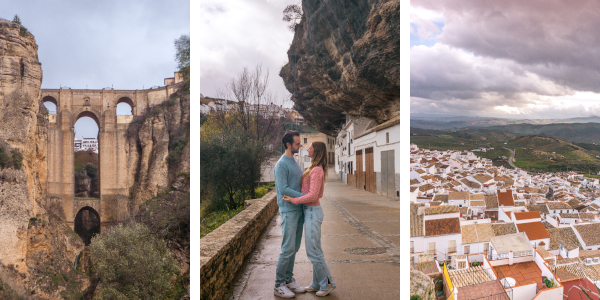
Ronda is a city in the mountains, located at around 750 meters above sea level. It’s one of the oldest cities of Spain, with remains found of prehistoric settlements dating back to Neolithic Period (around 3000 BC). In the 8th century, Ronda was ruled by the Moors. During the Moorish Era, the city flourished. Ronda even became an independent kingdom (Taifa of Ronda) from 1039 until 1065. The Moorish Era ended with the conquest of Ronda by the Christians in 1485. Due to its rich history, Ronda has a lot to offer in terms of architecture and sightseeing spots. Together with the mountainous area, offering beautiful views of the surrounding landscapes, as well as the 100-meter deep El Tajo canyon that divides the city in two, Ronda is a fascinating city and a must-visit in Andalusia. In this blog post, we’re sharing the best things to do in Ronda, including day trips to nearby white villages Villaluenga del Rosario, Setenil de las Bodegas and Olvera, that are just as interesting as Ronda.
Loop walk through Ronda
On this loop walk through Ronda, you can watch the city from different perspectives, as well as visiting some of Ronda’s best tourist attractions. It’s a great way to see everything Ronda has to offer in a short period of time. The walk is only 1,2 km and takes around 20 minutes without stops, but you’re going to want to stop a few times so prepare for at least a one-hour walk or even more if you want to visit all the attractions.
It’s also possible to book a guided tour of Ronda if you prefer that.
The loop walk starts at Puente Nuevo, one of the main sightseeing spots of Ronda. As you can tell by its name (New Bridge), it’s the newest of the three bridges that cross the Guadalevín River that runs through the over 100-meter deep El Tajo canyon. Puente Nuevo dates back to 1973, so it isn’t really new anymore. When standing on the bridge, you can’t admire the amazing arches of the bridge that carve deep into the canyon, but during the loop walk there are plenty of spots from where you can admire the bridge in all its glory.
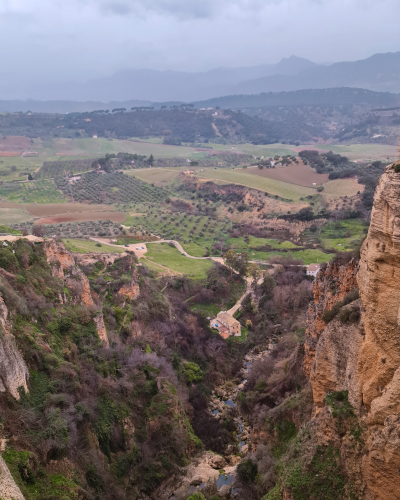
View from Puente Nuevo
From Puente Nuevo, walk north and take a right turn into Calle Rosario. Take the first two rights until you reach Jardines de Cuenca. Jardines de Cuenca are gardens made of different level terraces and offer views of the canyon and, of course, Puente Nuevo. In spring and summer, you can find all different kinds of flowers blooming in the gardens. However when we were in Ronda, the gardens unfortunately were closed due to bad weather (rain and heavy winds). There’s no entrance fee.
After admiring the views in Jardines de Cuenca, continue on Calle Escolleras to Puente Viejo. When crossing Puente Viejo, you’re greeted with beautiful views of Puente Romano, the canyon and the surrounding countryside.
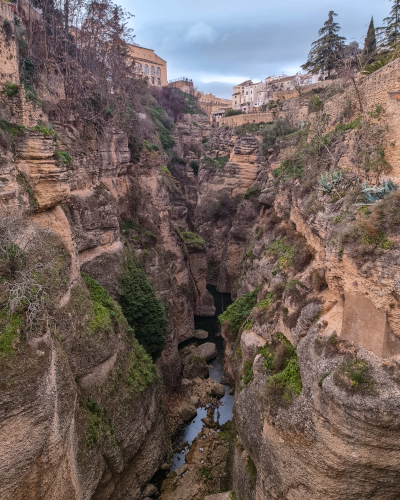
View of the canyon from Puente Viejo
After crossing Puente Viejo, you can either visit the Arab Baths or take the path up to Arco de Felipe V, which used to be part of Ronda’s city walls. The Arab Baths (Los baños árabes de Ronda) date back to the 13th and 14th century and are one of the best preserved Arab Baths in Spain. You can visit the Arab Baths for €4,50 per person. Check this website for the opening hours.
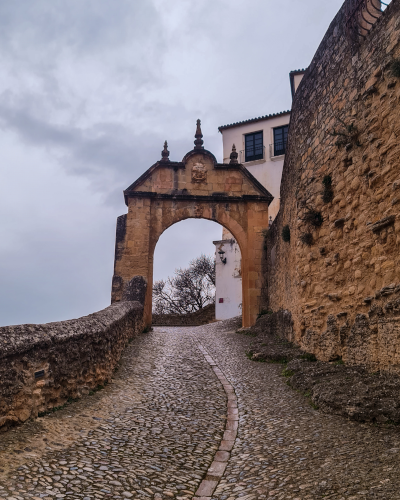
Arco de Felipe V
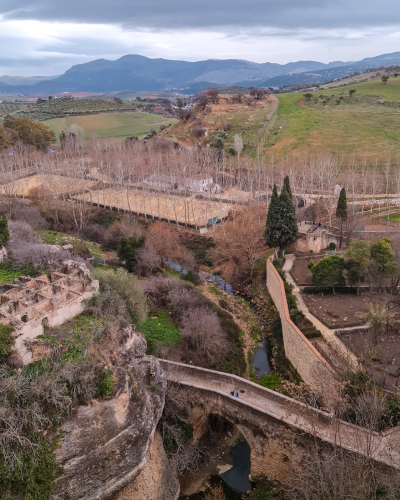
View of Puente Romano

View of Puente Viejo
When continuing the path uphill to the Arco de Felipe V, you can admire the canyon and the countryside from a different perspective, as well as viewing Puente Viejo from above. You’ll walk past the Casa del Rey Moro, which is an 18th century villa that’s open to visitors. The villa itself is currently under construction, but you can visit the gardens and the water mine. Despite its name, it was never the home of the Moorish King. The water mine dates back to the 14th century. With the Water Mine, water could be drawn from the river safely during a siege, as the water supply was the first thing the attackers destroyed during sieges. In our opinion, the entrance fee of €10 per person is a bit high when the villa itself is under construction and no garden looks its best in January. Therefore, we decided to skip this sightseeing spot. If you consider visiting Casa del Rey Moro, you can check this website for the current opening hours.
Continuing on Calle Santo Domingo, you’ll eventually get back to Puente Nuevo. Just before the bridge, there’s a viewing platform on your right that offers a great view of the bridge. The viewing platform is called Mirador de Aldehuela. Make sure to check out the views as they are amazing.
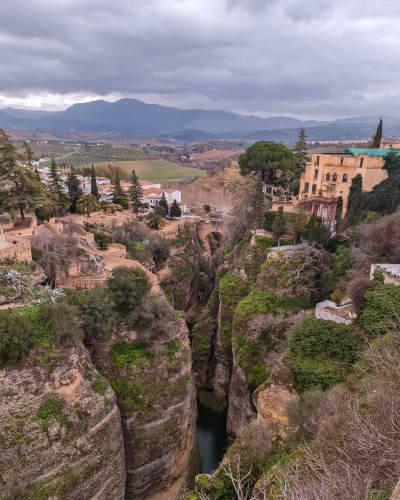
View of the canyon from Mirador de Aldehuela with Jardines de Cuenca to the left and Casa del Rey Moro to the right of the canyon

View of Puente Nuevo from Mirador de Aldehuela
Even though the loop walk ends at Puente Nuevo, we’d recommend to walk a little bit further after crossing the bridge and head to the left to Alameda del Tajo, a park on top of a cliff overlooking the countryside and mountains. You can walk along the cliff to Balcón del Coño while admiring the view.
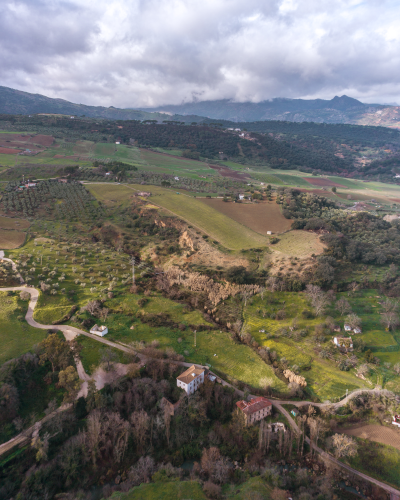
View from Alameda del Tajo
Plaza de Toros de Ronda is located next to Alameda del Tajo and Balcón del Coño. This bullring dates back to 1785 and, with a diameter of 66 meters, it’s the largest bullring in Spain. There’s a museum dedicated to the activities in the bullring. We wouldn’t recommend visiting the bullring because of the animal abuse that is associated with bullfighting.
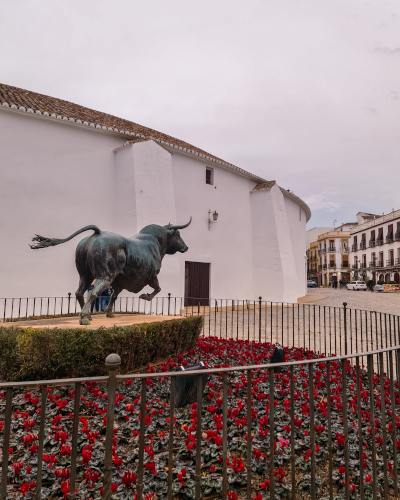
Plaza de Toros
Viewpoints of Puente Nuevo
Aside from the viewpoints of Puente Nuevo that you’ve witnessed on the loop walk, there are more viewpoints in the valley west of the bridge that are worth visiting. Southwest of the bridge is a hiking path that goes all the way down to the countryside. After a short hike on this path, there’s some kind of plateau offering an obstructed view of the Puente Nuevo. We thought that this might be the best viewpoint of the bridge, but unfortunately for us, the hiking path was under maintenance when we were in Ronda (the downside of traveling in low season). On Google Maps, the viewpoint is called Mirador Puente Nuevo de Ronda. Make sure to check it out during your visit in Ronda, and let us know in the comments below whether you think it’s the best view point of Puente Nuevo!
A viewpoint that we were able to get to in low season is Mirador la Hoya del Tajo. This viewpoint is a little further away from the city and is along the hiking path continuing from Mirador Puente Nuevo de Ronda. From the bridge it takes around 20 minutes by foot to get there. You can also get to this viewpoint by car, which we did, and takes only around 7 minutes. Be aware that the road to the viewpoint is very narrow. It’s a two-way road but most of the time there’s only enough space for one car. We’d recommend accessing the viewpoint by car coming from the south, because this road is shorter and less narrow than the road from the north.
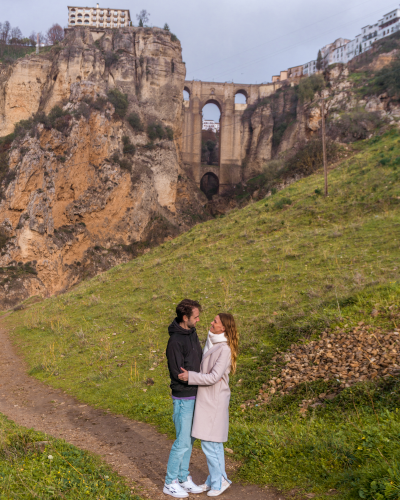
View of Puente Nuevo

You can take a path a little more higher up for a less obstructed view of the bridge
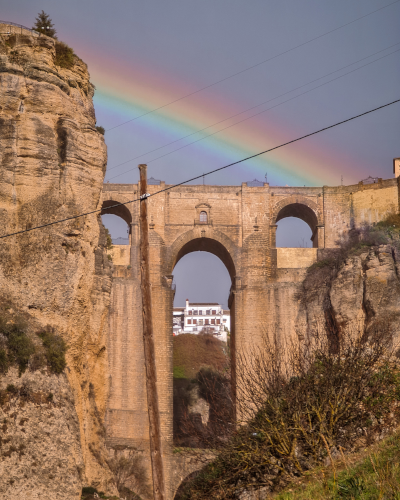
We witnessed this beautiful rainbow!
City center
When you’re done with all the sightseeing in Ronda, make sure to walk through the city center. Carrera Espinel is Ronda’s main shopping street and is lined with all different kinds of stores, such as clothing stores, souvenirs stores, gift stores, as well as plenty of cafés and restaurants.
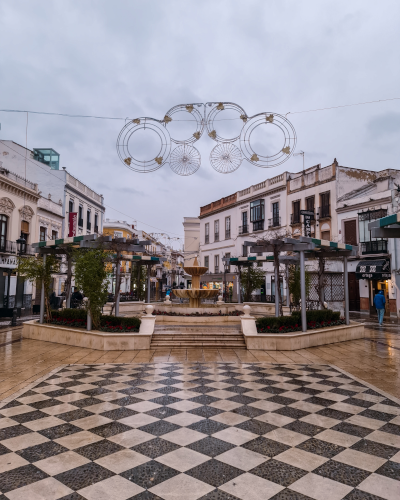
Plaza del Socorro
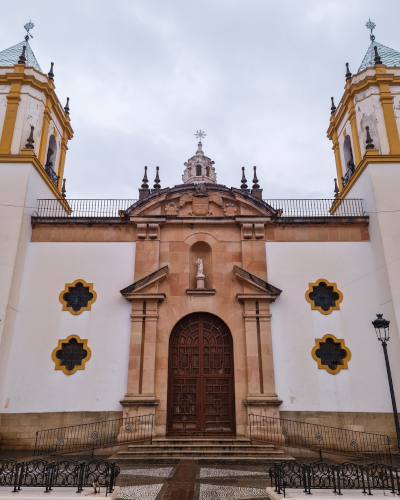
Parroquia de Nuestra Señora del Socorro
If you’re looking for a place to eat, we can highly recommend Las Maravillas. They serve typical Spanish tapas and plates for a decent price. We’d recommend getting there a bit early (around 19:00) to secure a spot for dinner as the restaurant is fully packed every night from 20:00 onwards.
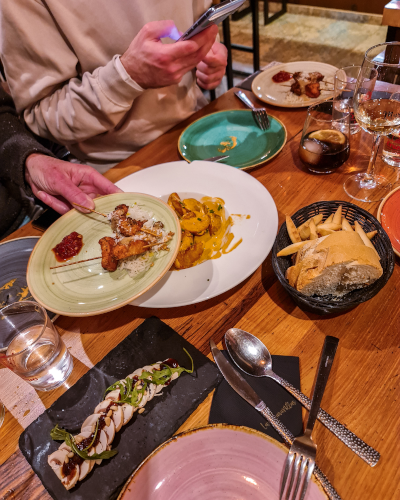
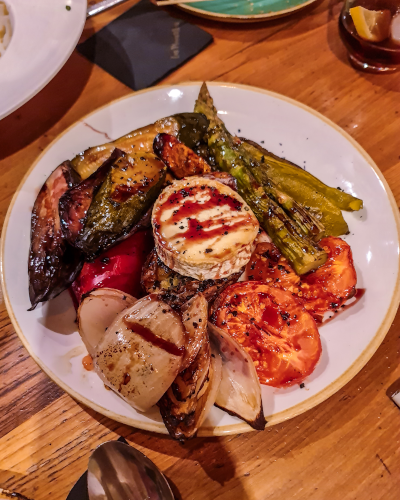
Dinner at Las Maravillas
Places to visit near Ronda
There are a few white villages within a one-hour drive from Ronda that are very much worth visiting. During our stay in Ronda, we visited Villaluenga del Rosario, Setenil de las Bodegas and Olvera. For these day trips outside of Ronda, we’d recommend going by car as we couldn’t find any connections with public transport. If you don’t have your own transport, we’d recommend booking a tour with a guide and transportation. For instance this day trip from Ronda to Setenil de las Bodegas.
Villaluenga del Rosario
Villaluenga del Rosario is a tiny village in the mountains, a 45-minute drive from Ronda. This beautiful village filled with white houses is located 858 meters above sea level and has less than 450 inhabitants, making it the highest and at the same time the smallest village in the province of Cádiz. After parking the car at the public park, we strolled through the streets without a fixed plan.
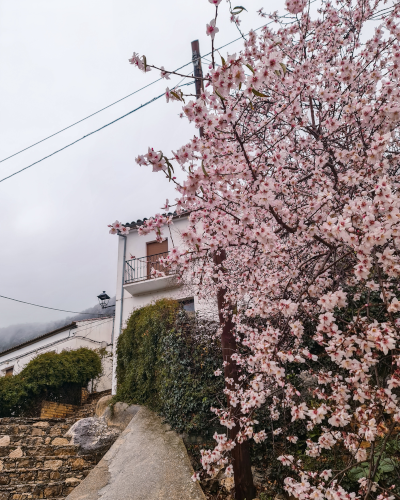
The almond trees were blooming
Because of the small size of the village, you can’t get lost. In less than an hour, you’ve seen every corner of the village. A spot that you can’t miss is Mirador Villaluenga del Rosario, which is a small observation platform up a few stairs and is the best place to admire the white-washed houses.
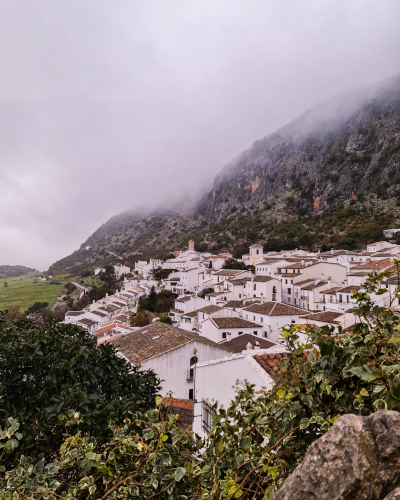
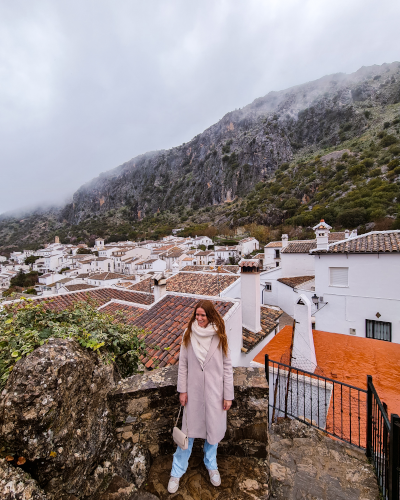
Mirador in Villaluenga del Rosario
On the west end of the village, there’s a unique cemetery located in a ruined church, Cementerio. It’s a very interesting sight.
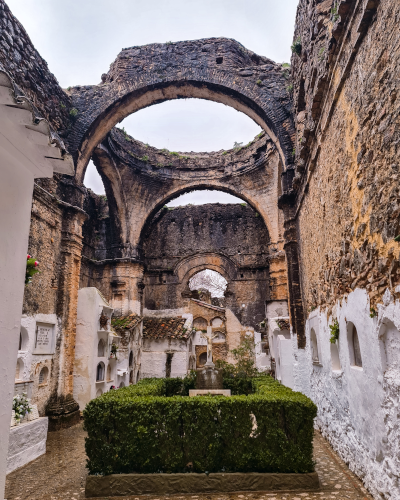
Cemetery
Despite its small size, there even is a Plaza de Toros in the village, which is the oldest bullring in the province Cadíz. The bullring is unique as the shape is not round, but octagonal. When we walked past it, we could take a peek inside.
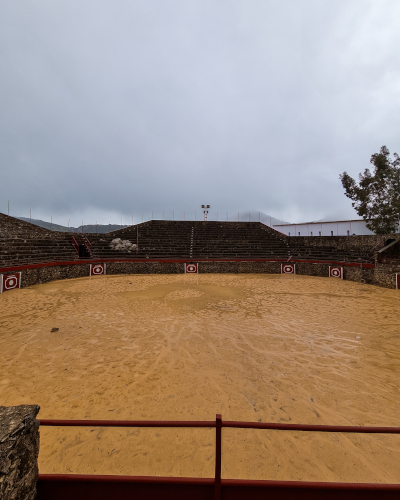
Plaza de Toros
Setenil de las Bodegas
Setenil de las Bodegas is a very unique village mostly known for its cave houses. With around 3000 inhabitants, it’s significantly larger than Villaluenga del Rosario, and it’s only a 20-minute drive from Ronda. We parked our car in the paid underground parking garage Parking Los Caños and headed to Calle Cabrerizas. If you want to take photos, Calle Cabrerizas is perfect for this as it’s a quiet street with an overhanging rock and the typical cave houses carved into the rock.
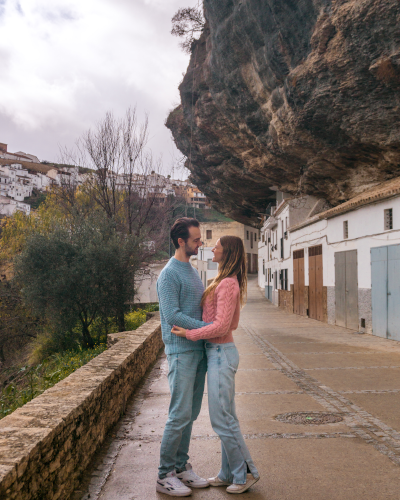
Calle Cabrerizas
There are two restaurants in this street too where you can enjoy a bite. We had lunch at Bajo la Roca, which was a unique experience to eat in a cave house.
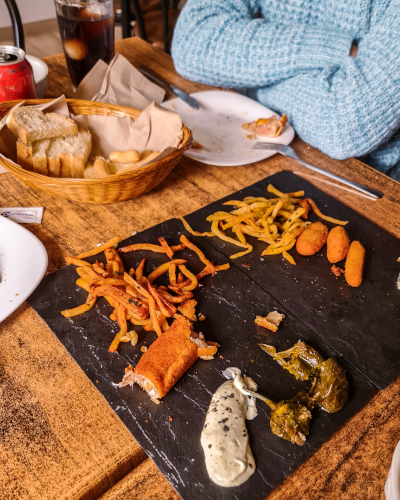
Lunch in a cave restaurant
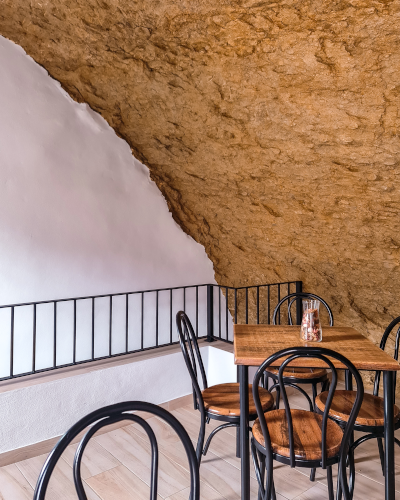
You could really tell we were next to the rocks
After lunch, we strolled through the village for a bit. We walked up to Castillo de Setenil de las Bodegas, which wasn’t open during our visit, but Calle Vila just south of the castle, offered amazing views of the village. From up here, Setenil de las Bodegas doesn’t really look like a cave house village anymore, but more like a hill-top village. Nevertheless, the view is mesmerizing and we could watch it for hours.
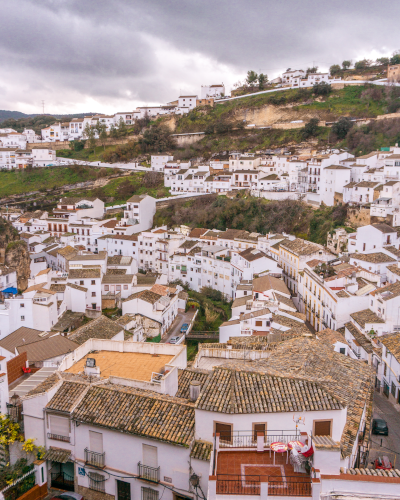
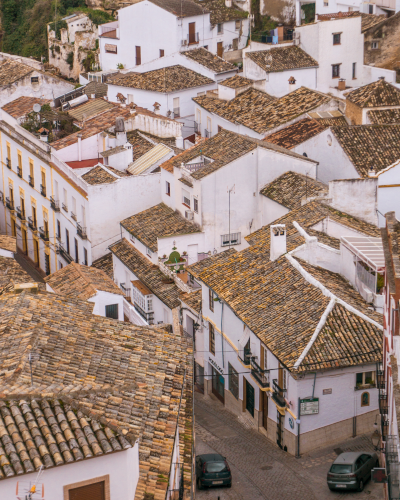
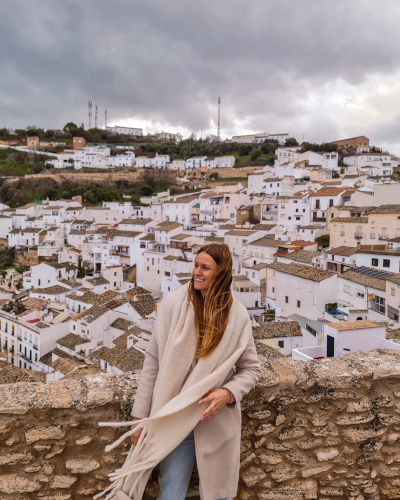
View of Setenil de las Bodegas
When you’re done admiring the views, you could continue walking to Calle Cuevas del Sol, which is the main cave house street that you’ll recognize from the photos. However, we decided to go back in the car to visit our next destination.
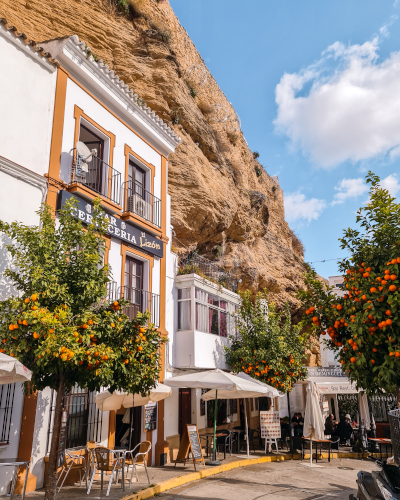
Plaza de Andalucía
Olvera
Olvera is a 30-minute drive from Setenil de las Bodegas or a 45-minute drive from Ronda. When driving towards Olvera, you can recognize the town from afar, due to the church towering on top of a hill above the town. With around 9000 inhabitants, Olvera is the largest of these three places near Ronda that we’ve visited. We’d recommend limiting your visit in Olvera to the Barrio de la Villa, the neighborhood surrounding the church Iglesia Mayor Parroquial. We parked our car at Parking Plaza Matadero, a free parking place, and walked uphill to Barrio de la Villa. We’d highly recommend stopping by Calle Mayén as it’s the most picturesque street of the town. This small street is decorated with lots of potted plants and flowers. Even in January, which is the worst month for flowers and plants, the street looked so pretty. There were signs on the facades of the houses stating that prices had been won for the decorations.
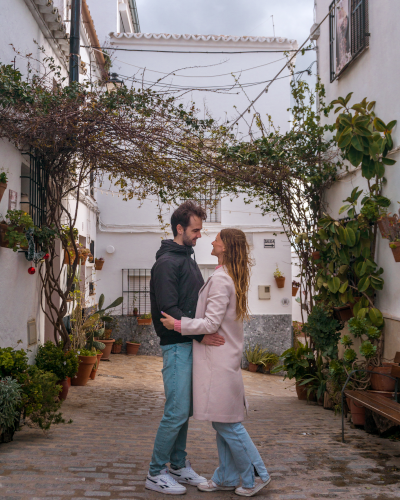
Calle Mayén

Streets of Olvera
Another must-visit in Olvera is Plaza de la Iglesia. The square was under maintenance when we were there, but we could still access the observation platform in front of the church offering incredible views of Olvera, the countryside and the mountains.
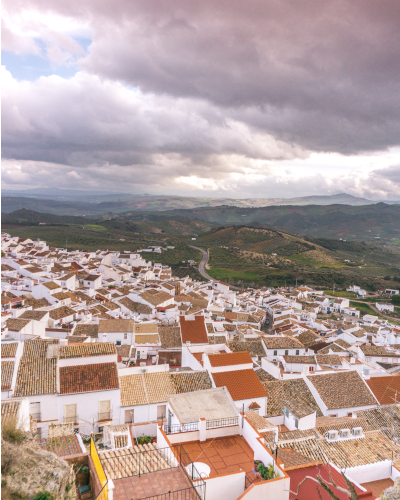
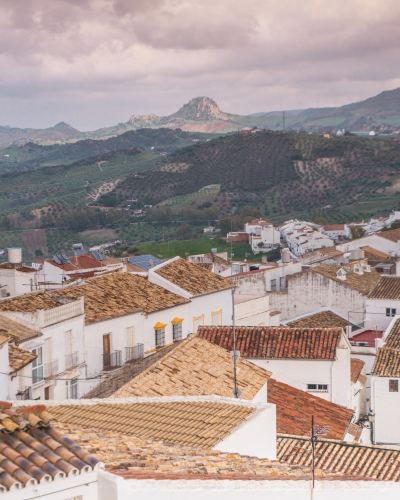
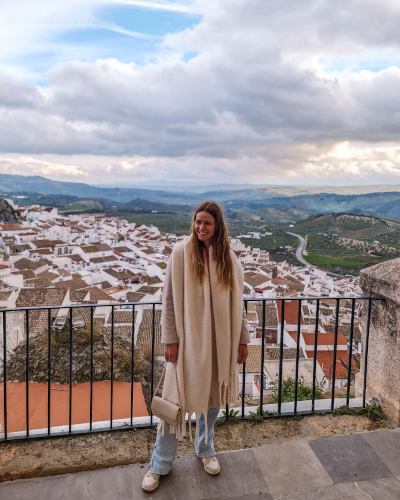
View from Plaza de la Iglesia
Close to the church, there’s a castle in ruins on top of a hill: Castillo de Olvera. The castle dates back to the 12the century and was part of the town’s defense system. The castle is open to visitors. When we visited in January, it was only open until the beginning of the afternoon, and as we were in Olvera at the end of the afternoon, it was already closed.
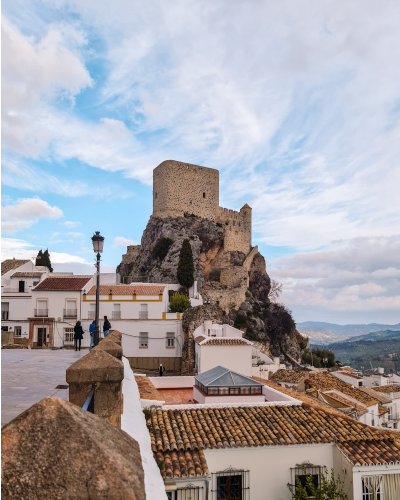
Castillo de Olvera
How long to stay in Ronda
We stayed in Ronda for three nights, which was perfect to see Ronda and to visit the nearby white villages and towns. If you only want to visit Ronda, it’s more than enough to stay one night or even visit Ronda on a day trip from a nearby city such as Malaga or Sevilla. Ronda isn’t a big city and one day is enough to see it all.
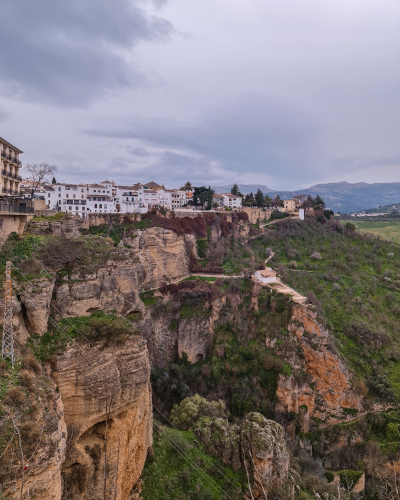
Best time to visit Ronda
In our opinion, you could visit Ronda any time of the year. However, we would recommend avoiding the summer months of July and August because of the high temperatures in the South of Spain. Especially in the last few years, it’s not uncommon that temperatures can reach highs of 35 degrees Celsius or more, which is way too high for sightseeing in our opinion. Furthermore, July and August are the most crowded months due to summer vacations in Europe. We visited Ronda in January. In general during our two week stay in the South of Spain, we had great weather with mild temperatures (17 to 22 degrees Celsius) and lots of sun, but in Ronda we had a bit of bad luck with the weather. On two of the three days in Ronda it rained a lot with lots of heavy winds. With temperatures around 13 degrees Celsius, it was reasonable for January but the wind made it feel cold. Furthermore, there was a lot of maintenance work in sightseeing spots or hiking paths, so we couldn’t always visit all the places we wanted to. This is something to keep in mind if you’re visiting Ronda in January. Also keep in mind that even though January is considered the less crowded month in terms of tourists, we thought there were still a lot of tourists. We can imagine there to be even more in other months though.
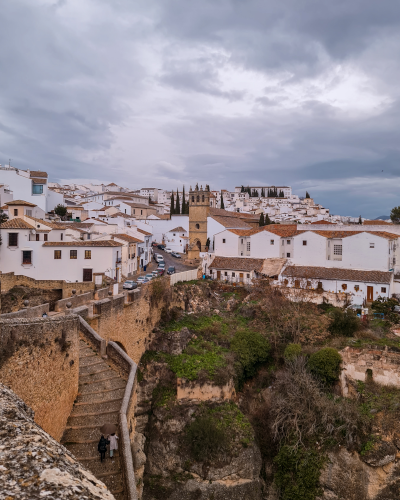
Where to stay in Ronda
We stayed in an apartment that we booked through Booking called Apartamento Artesanos Ronda, and it wasn’t great. The apartment was large with three bedrooms, two bathrooms, a separate kitchen and living room. However, it was outdated, there was no central heating and somehow it was colder inside than it was outside, which I can imagine is great in summer, but not so much in winter. As we were traveling with four adults, we specifically booked this apartment because of the two bathrooms. However, one of the two bathrooms didn’t get any hot water at all in the shower and the other bathroom constantly ran out of hot water, making it near-impossible to shower. There’s a parking garage in the building, however, the owner didn’t let us use it. Parking on the street is free of charge, but the spots are very small and to avoid any parking damage made by others, we ended up parking in a paid parking place. The location was good with just a 10-minute walk to the city center. Don’t let this hold you back from visiting Ronda though, as there are plenty of places to stay in the city with good reviews. Just avoid the apartment we stayed at. 🙂
Click here to find a nice accommodation in Ronda.
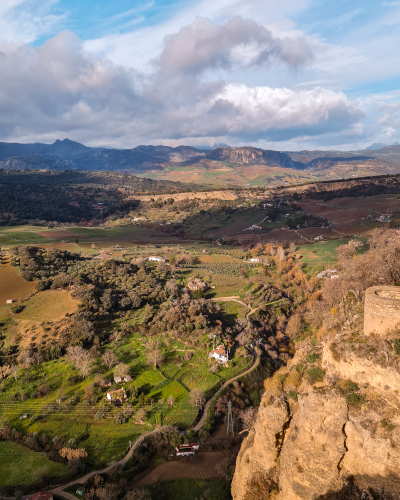
We hope you’ve enjoyed our guide to the best things to do in and near Ronda and that our blog post inspired you to visit this beautiful city in the South of Spain. Have you been to Ronda or is it still on your travel bucket list? Let us know in the comments below!
Be sure to check out:
- our online prints store KIPAVISTA.com
- our daily life updates on Instagram
- our YouTube Channel
- our TikTok
More Spain
Discovering Bilbao: A Guide to the Best Things to See and Do
The Best Places to Visit Along the Costa Brava
10 Amazing Places to Eat in Barcelona

